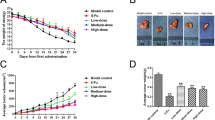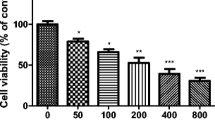Abstract
Gastric cancer (GC) is the most common cancer worldwide and the third leading cause of cancer death, with the fifth highest incidence. The development of effective chemotherapeutic agents is needed to decrease GC mortality. Policosanol (PC) extracted from Cuban sugar cane wax is a healthy functional food ingredient that helps improve blood cholesterol levels and blood pressure. Its various physiological activities, such as antioxidant, anti-inflammatory, and anticancer activities, have been reported recently. Nevertheless, the therapeutic efficacy of PC in gastric xenograft models is unclear. We aimed to investigate the anticancer effect of PC on human GC SNU-16 cells and a xenograft mouse model. PC significantly inhibited GC cell viability and delayed tumor growth without toxicity in the SNU-16–derived xenograft model. Therefore, we investigated protein expression levels in tumor tissues; the expression levels of Ki-67, a proliferation marker, and cdc2 were decreased. In addition, we performed proteomic analysis and found thirteen differentially expressed proteins. Our results suggested that PC inhibited GC progression via cdc2 suppression and extracellular matrix protein regulation. Notably, our findings might contribute to the development of novel and effective therapeutic strategies for GC.




Similar content being viewed by others
References
Sung H, Ferlay J, Siegel RL, Laversanne M, Soerjomataram I, Jemal A, Bray F (2021) Global Cancer Statistics 2020: GLOBOCAN estimates of incidence and mortality worldwide for 36 cancers in 185 countries. CA Cancer J Clin 71:209–249. https://doi.org/10.3322/caac.21660
Petrillo A, Smyth EC (2020) Biomarkers for precision treatment in gastric cancer. Visc Med 36:364–372. https://doi.org/10.1159/000510489
Xu HB, Huang F, Su R, Shen FM, Lv QZ (2015) Capecitabine plus oxaliplatin (XELOX) compared with 5-fluorouracil/leucovorin plus oxaliplatin (FOLFOXs) in advanced gastric cancer: meta-analysis of randomized controlled trials. Eur J Clin Pharmacol 71:589–601. https://doi.org/10.1007/s00228-015-1828-9
Sudo K, Yamada Y (2015) Advancing pharmacological treatment options for advanced gastric cancer. Expert Opin Pharmacother 16:2293–2305. https://doi.org/10.1517/14656566.2015.1080238
Joshi SS, Badgwell BD (2021) Current treatment and recent progress in gastric cancer. CA Cancer J Clin 71:264–279. https://doi.org/10.3322/caac.21657
Shen J, Luo F, Lin Q (2019) Policosanol: Extraction and biological functions. J Funct Food 57:351–360. https://doi.org/10.1016/j.jff.2019.04.024
Jang YS, Kim DE, Han E, Jung J (2019) Physiological activities of policosanol extracted from sugarcane wax. Nat Prod Sci 25:293–297. https://doi.org/10.20307/nps.2019.25.4.293
de Oliveira AM, Conserva LM, de Souza Ferro JN, de Almeida Brito F, Lyra Lemos RP, Barreto E (2012) Antinociceptive and anti-inflammatory effects of octacosanol from the leaves of Sabicea grisea var. grisea in mice. Int J Mol Sci 13:1598–1611. https://doi.org/10.3390/ijms13021598
Thippeswamy G, Sheela ML, Salimath BP (2008) Octacosanol isolated from Tinospora cordifolia downregulates VEGF gene expression by inhibiting nuclear translocation of NF-κB and its DNA binding activity. Eur J Pharmacol 588:141–150. https://doi.org/10.1016/j.ejphar.2008.04.027
Guo T, Lin Q, Li X, Nie Y, Wang L, Shi L, Xu W, Hu T, Guo T, Luo F (2017) Octacosanol attenuates inflammation in both RAW264.7 macrophages and a mouse model of colitis. J Agric Food Chem 65:3647–3658. https://doi.org/10.1021/acs.jafc.6b05465
Park JG, Frucht H, LaRocca RV, Bliss DP Jr, Kurita Y, Chen TR, Henslee JG, Trepel JB, Jensen RT, Johnson BE et al (1990) Characteristics of cell lines established from human gastric carcinoma. Cancer Res 50:2773–2780. https://pubmed.ncbi.nlm.nih.gov/2158397
Banerjee S, Ghoshal S, Porter TD (2011) Activation of AMP-kinase by policosanol requires peroxisomal metabolism. Lipids 46:311–321. https://doi.org/10.1007/s11745-011-3540-6
Ishaka A, Umar Imam M, Mahamud R, Zuki AB, Maznah I (2014) Characterization of rice bran wax policosanol and its nanoemulsion formulation. Int J Nanomed 9:2261–2269. https://doi.org/10.2147/IJN.S56999
Kim JY, Lee JH, Jeong DY, Jang DK, Seo TR, Lim ST (2015) Preparation and characterization of aqueous dispersions of dextrin and policosanol composites. Carbohydr Polym 121:140–146. https://doi.org/10.1016/j.carbpol.2014.12.050
Oh S, Kwon HJ, Jung J (2022) Estrogen exposure causes the progressive growth of SK-Hep1-derived tumor in ovariectomized mice. Toxicol Res 38:1–7. https://doi.org/10.1007/s43188-021-00100-6
Singh DK, Li L, Porter TD (2006) Policosanol inhibits cholesterol synthesis in hepatoma cells by activation of AMP-kinase. J Pharmacol Exp Ther 318:1020–1026. https://doi.org/10.1124/jpet.106.107144
Aleman CL, Puig MN, Elias EC, Ortega CH, Guerra IR, Ferreiro RM, Briñis F (1995) Carcinogenicity of policosanol in mice: an 18-month study. Food Chem Toxicol 33:573–578. https://doi.org/10.1016/0278-6915(95)00026-x
Lee JH, Jia Y, Thach TT, Han Y, Kim B, Wu C, Kim Y, Seo WD, Lee SJ (2017) Hexacosanol reduces plasma and hepatic cholesterol by activation of AMP-activated protein kinase and suppression of sterol regulatory element-binding protein-2 in HepG2 and C57BL/6J mice. Nutr Res 43:89–99. https://doi.org/10.1016/j.nutres.2017.05.013
Liu YW, Zuo PY, Zha XN, Chen XL, Zhang R, He XX, Liu CY (2015) Octacosanol enhances the proliferation and migration of human umbilical vein endothelial cells via activation of the PI3K/Akt and MAPK/Erk pathways. Lipids 50:241–251. https://doi.org/10.1007/s11745-015-3991-2
Varady KA, Wang Y, Jones PJ (2003) Role of policosanols in the prevention and treatment of cardiovascular disease. Nutr Rev 61:376–383. https://doi.org/10.1301/nr.2003.nov.376-383
Wang T, Liu Y, Yang N, Ji C, Chan P, Zuo P (2012) Anti-parkinsonian effects of octacosanol in 1-methyl-4-phenyl-1,2,3,6 tetrahydropyridine-treated mice. Neural Regen Res 7:1080–1087. https://doi.org/10.3969/j.issn.1673-5374.2012.14.006
Su CC (2014) Tanshinone IIA inhibits gastric carcinoma AGS cells through increasing p-p38, p-JNK and p53 but reducing p-ERK, CDC2 and cyclin B1 expression. Anticancer Res 34:7097–7110. https://pubmed.ncbi.nlm.nih.gov/25503137
Zhou B, Bu G, Zhou Y, Zhao Y, Li W, Li M (2015) Knockdown of CDC2 expression inhibits proliferation, enhances apoptosis, and increases chemosensitivity to temozolomide in glioblastoma cells. Med Oncol 32:378. https://doi.org/10.1007/s12032-014-0378-9
Henke E, Nandigama R, Ergun S (2019) Extracellular matrix in the tumor microenvironment and its impact on cancer therapy. Front Mol Biosci 6:160. https://doi.org/10.3389/fmolb.2019.00160
Nallanthighal S, Heiserman JP, Cheon DJ (2019) The role of the extracellular matrix in cancer stemness. Front Cell Dev Biol 7:86. https://doi.org/10.3389/fcell.2019.00086
Rabajdova M, Urban P, Spakova I, Saksun L, Dudic R, Ostro A, Caprnda M, Kruzliak P, Adamek M, Marekova M (2016) The crucial role of emilin 1 gene expression during progression of tumor growth. J Cancer Res Clin Oncol 142:2397–2402. https://doi.org/10.1007/s00432-016-2226-0
Danussi C, Petrucco A, Wassermann B, Modica TM, Pivetta E, Del Bel Belluz L, Colombatti A, Spessotto P (2012) An EMILIN1-negative microenvironment promotes tumor cell proliferation and lymph node invasion. Cancer Prev Res (Phila) 5:1131–1143. https://doi.org/10.1158/1940-6207.CAPR-12-0076-T
Amor López A, Mazariegos MS, Capuano A, Ximénez-Embún P, Hergueta-Redondo M, Recio J, Muñoz E, Al-Shahrour F, Muñoz J, Megías D, Doliana R, Spessotto P, Peinado H (2021) Inactivation of EMILIN-1 by proteolysis and secretion in small extracellular vesicles favors melanoma progression and metastasis. Int J Mol Sci 22:7406. https://doi.org/10.3390/ijms22147406
Qi Y, Lv J, Liu S, Sun L, Wang Y, Li H, Qi W, Qiu W (2019) TSPAN9 and EMILIN1 synergistically inhibit the migration and invasion of gastric cancer cells by increasing TSPAN9 expression. BMC Cancer 19:630. https://doi.org/10.1186/s12885-019-5810-2
Liu J, Shen JX, Wu HT, Li XL, Wen XF, Du CW, Zhang GJ (2018) Collagen 1A1 (COL1A1) promotes metastasis of breast cancer and is a potential therapeutic target. Discov Med 25:211–223. https://pubmed.ncbi.nlm.nih.gov/25503137
Zhang Z, Wang Y, Zhang J, Zhong J, Yang R (2018) COL1A1 promotes metastasis in colorectal cancer by regulating the WNT/PCP pathway. Mol Med Rep 17:5037–5042. https://doi.org/10.3892/mmr.2018.8533
Hou L, Lin T, Wang Y, Liu B, Wang M (2021) Collagen type 1 alpha 1 chain is a novel predictive biomarker of poor progression-free survival and chemoresistance in metastatic lung cancer. J Cancer 12:5723–5731. https://doi.org/10.7150/jca.59723
Dong XZ, Zhao ZR, Hu Y, Lu YP, Liu P, Zhang L (2020) LncRNA COL1A1-014 is involved in the progression of gastric cancer via regulating CXCL12-CXCR4 axis. Gastric Cancer 23:260–272. https://doi.org/10.1007/s10120-019-01011-0
Yu Y, Liu D, Liu Z, Li S, Ge Y, Sun W, Liu B (2018) The inhibitory effects of COL1A2 on colorectal cancer cell proliferation, migration, and invasion. J Cancer 9:2953–2962. https://doi.org/10.7150/jca.25542
Yoshida T, Akatsuka T, Imanaka-Yoshida K (2015) Tenascin-C and integrins in cancer. Cell Adh Migr 9:96–104. https://doi.org/10.1080/19336918.2015.1008332
Zhao SF, Yin XJ, Zhao WJ, Liu LC, Wang ZP (2020) Biglycan as a potential diagnostic and prognostic biomarker in multiple human cancers. Oncol Lett 19:1673–1682. https://doi.org/10.3892/ol.2020.11266
Yeung TL, Leung CS, Yip KP, Sheng J, Vien L, Bover LC, Birrer MJ, Wong STC, Mok SC (2019) Anticancer Immunotherapy by MFAP5 blockade inhibits fibrosis and enhances chemosensitivity in ovarian and pancreatic cancer. Clin Cancer Res 25:6417–6428. https://doi.org/10.1158/1078-0432.CCR-19-0187
Huang H, Hao Z, Long L, Yin Z, Wu C, Zhou X, Zhang B (2021) Dermatopontin as a potential pathogenic factor in endometrial cancer. Oncol Lett 21:408. https://doi.org/10.3892/ol.2021.12669
Tillement V, Haren L, Roullet N, Etievant C, Merdes A (2009) The centrosome protein NEDD1 as a potential pharmacological target to induce cell cycle arrest. Mol Cancer 8:10. https://doi.org/10.1186/1476-4598-8-10
Rodriguez PC, Quiceno DG, Zabaleta J, Ortiz B, Zea AH, Piazuelo MB, Delgado A, Correa P, Brayer J, Sotomayor EM, Antonia S, Ochoa JB, Ochoa AC (2004) Arginase I production in the tumor microenvironment by mature myeloid cells inhibits T-cell receptor expression and antigen-specific T-cell responses. Cancer Res 64:5839–5849. https://doi.org/10.1158/0008-5472.CAN-04-0465
Zhou Q, Andersson R, Hu D, Bauden M, Kristl T, Sasor A, Pawłowski K, Pla I, Hilmersson KS, Zhou M, Lu F, Marko-Varga G, Ansari D (2019) Quantitative proteomics identifies brain acid soluble protein 1 (BASP1) as a prognostic biomarker candidate in pancreatic cancer tissue. EBioMedicine 43:282–294. https://doi.org/10.1016/j.ebiom.2019.04.008
Funding
Tis research was funded by Ministry of Education, Grant no [2021R1A6A3A01086368], NRF by Korea, Grant no [2021R1A2C200453511] and the Priority Research Centers Program through the NRF, Grant no [2016R1A6A1A03007648].
Author information
Authors and Affiliations
Corresponding author
Ethics declarations
Conflict of interest
The authors have not disclosed any competing interests.
Additional information
Publisher’s Note
Springer Nature remains neutral with regard to jurisdictional claims in published maps and institutional affiliations.
Rights and permissions
About this article
Cite this article
Lee, S., Lee, G.S., Moon, J.H. et al. Policosanol suppresses tumor progression in a gastric cancer xenograft model. Toxicol Res. 38, 567–575 (2022). https://doi.org/10.1007/s43188-022-00139-z
Received:
Revised:
Accepted:
Published:
Issue Date:
DOI: https://doi.org/10.1007/s43188-022-00139-z




